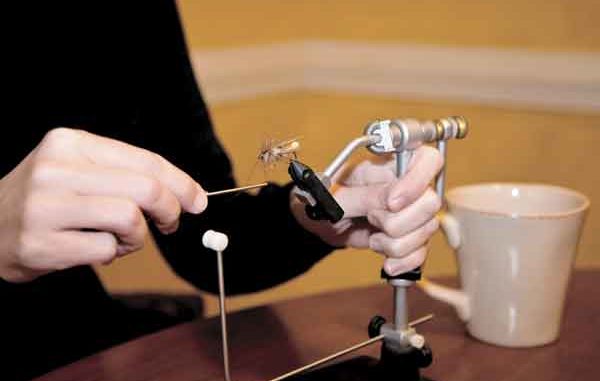
At some time during the frozen doldrums of mid-winter, when most anglers are merely trying to maintain dominion over their sanity, the ardent fly fisherman takes up fly-tying.
Learning to tie your own flies can expand your fishing knowledge, fishing pleasure, and ultimately, your catch rate. You might take up fly-tying to cut costs on store-bought flies or to immerse yourself in the finer aspects of the sport. If nothing else, it relieves boredom on cold winter evenings and vicariously delivers you closer to the water. It’s no wonder that many fly fishermen consider tying to be a natural extension of the sport.
So you have decided to give this a try. Where do you begin?
Before purchasing a fly-tying kit and jumping into it with both feet, I would advise seeking instruction and materials from your local fly-fishing shop, fly-tying friends or area fly-fishing clubs. If these resources are not readily available, many excellent fly-tying videos, DVDs, and books exist to help the beginner get started.
As far as equipment goes, let’s start with the vice, perhaps the most important tool you will use. A good fly vise must hold a variety of hook sizes and shapes securely. Any vise that takes too much time or manipulation to adjust to specific hooks or sizes should be avoided. One or two twists of a knob should be enough effort to set any vise to a specific hook. After minimum adjustments, a good vise should clamp down on a hook with a simple twist of a knob, squeeze of a lever, or push of a cam.
Another consideration is how the vise is supported. A clamp works well if you have a permanent tying bench or table. A pedestal base is much more convenient if you are working at the kitchen table or if you are traveling. The pedestal base supports the vise with a heavy, weighted foundation and can be moved easily from location to location. Most models can be purchased with either option.
Several tools that perform different functions are used in fly-tying.
Bobbins come in a variety of sizes and shapes, but they all essentially perform the same roll — holding the spool of thread and guiding it through a small tube so that it is directed to the desired spot on the hook. A good bobbin never cuts or frays the thread and delivers it smoothly from the spool.
Good scissors are an absolute necessity. Your fly-tying scissors should have finger loops large enough to at least fit over your thumb. Scissors that are too small or too large make tying much more difficult than it needs to be.
Hackle pliers are simply small pliers with constant tension designed to wrap hackle feathers around the hook. Trying to hold these feathers with your fingers while rotating the fly is a nearly impossible task. Hackle pliers make this important maneuver much easier.
Hackle guards are designed to hold the hackle away from the hook eye when you tie the finish knot on the fly’s head. You can tie flies without them, but again, they make this task much easier.
Hair stackers are designed to align the tips of hair you’re using for wings, heads and tails. They come in a variety of sizes, and most tiers own several of these for different flies. Tying a No. 6 deer-hair bass bug would require a bigger hair stacker than a No. 18 Elk hair caddis.
Other tools exist that may be considered optional, but those listed above are a good start. You can purchase as many extras, however, as your ambition and wallet will allow.
There are few thrills in fly-fishing as exciting as catching a fish on your own fly. Whether it’s a rainbow trout on your own dry fly or a chunky 15-inch largemouth bass on a deer-hair popper you spun yourself, these are the moments and memories that tying so rewarding. They are also what drive us to put on a pot of coffee and sit down at the fly-tying vise on those cold winter evenings.




Be the first to comment